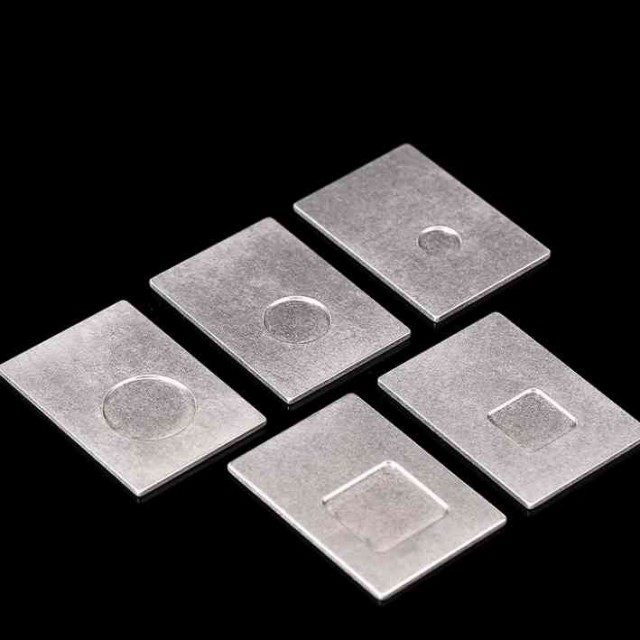
Optical Materials
Customizable XRD Sample Holders for Diverse Research Applications
Item Number : KTOM-ABG
Price varies based on specs and customizations
- Material
- Aluminum Alloy
- Processing technology
- Cold Working
Shipping:
Contact us to get shipping details Enjoy On-time Dispatch Guarantee.
Why Choose Us
Reliable PartnerEasy ordering process, quality products, and dedicated support for your business success.
Introduction
This high-quality XRD sample holder is engineered for precision and reliability in X-ray diffraction analysis. Crafted from a high-purity aluminum alloy, it provides a stable and flat platform for a wide range of powder and solid samples. Its design minimizes background noise, ensuring that you can obtain accurate and dependable diffraction data. These holders are available with both square and round sample wells and are fully customizable in size and groove depth to meet your specific experimental requirements.
Key Features and Advantages
- Superior Material: Constructed from a specialized aluminum alloy, our sample holders are designed to reduce background interference, leading to clearer and more reliable diffraction patterns.
- Full Customization: We offer complete customization of the holder's dimensions, including the shape (square or round) and depth of the sample well, to perfectly accommodate your sample volume and type.
- Precision Engineering: Each holder is manufactured to provide a consistently flat surface, ensuring uniform sample irradiation and yielding high-quality, reproducible results.
- Broad Compatibility: These sample holders are designed to be compatible with a wide array of diffractometer systems from leading manufacturers, including Bruker, Shimadzu, Panalytical, and Rigaku.
Detail & Parts
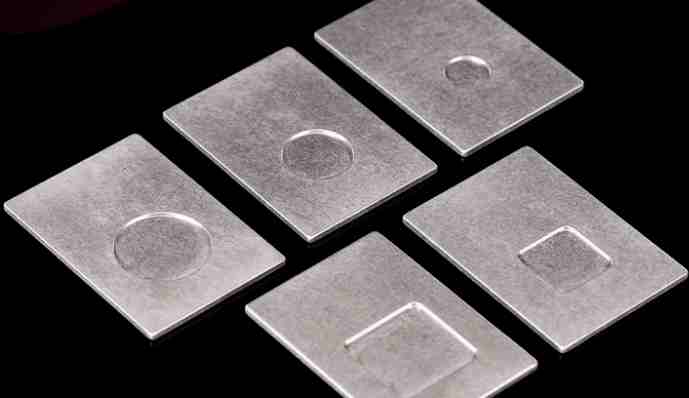
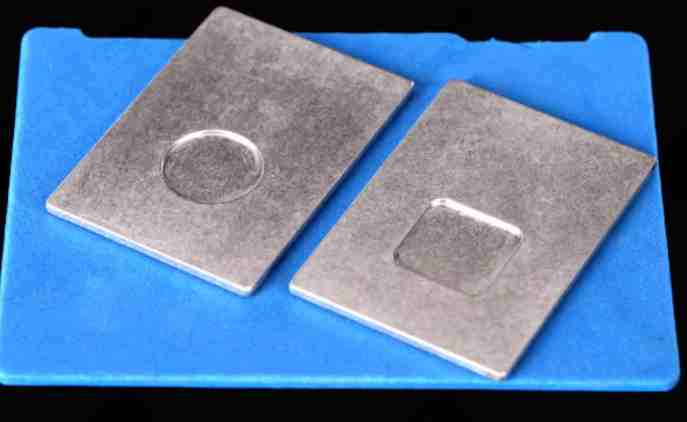
Standard Specifications
Below is a list of our standard available configurations. Please note that custom sizes are available upon request.
| Indentation Shape | Indentation Dimensions (mm) | Indentation Depth (mm) | Overall Dimensions (mm) |
|---|---|---|---|
| Square | 5 x 5 | 0.5 | 50 x 35 x 2 |
| Square | 10 x 10 | 0.5 | 50 x 35 x 2 |
| Square | 15 x 15 | 0.5 | 50 x 35 x 2 |
| Square | 20 x 20 | 0.5 | 50 x 35 x 2 |
| Round | ⌀5 | 0.5 | 50 x 35 x 2 |
| Round | ⌀10 | 0.5 | 50 x 35 x 2 |
| Round | ⌀15 | 0.5 | 50 x 35 x 2 |
| Round | ⌀20 | 0.5 | 50 x 35 x 2 |
| Square | 5 x 5 | 0.5 | 55 x 35 x 2 |
| Square | 10 x 10 | 0.5 | 55 x 35 x 2 |
| Square | 15 x 15 | 0.5 | 55 x 35 x 2 |
| Square | 20 x 20 | 0.5 | 55 x 35 x 2 |
| Round | ⌀5 | 0.5 | 55 x 35 x 2 |
| Round | ⌀10 | 0.5 | 55 x 35 x 2 |
| Round | ⌀15 | 0.5 | 55 x 35 x 2 |
| Round | ⌀20 | 0.5 | 55 x 35 x 2 |
To ensure our product perfectly matches your unique research needs, we encourage you to discuss your specific requirements with us. For a personalized quote or to design a custom sample holder for your diffractometer, please get in touch with our technical team through our contact form. We look forward to providing a solution that enhances the accuracy and efficiency of your work. Reach out to us at #ContactForm.
Designed for You
KinTek provide deep custom made service and equipment to worldwide customers, our specialized teamwork and rich experienced engineers are capable to undertake the custom tailoring hardware and software equipment requirements, and help our customer to build up the exclusive and personalized equipment and solution!
Would you please drop your ideas to us, our engineers are ready for you now!
FAQ
What Are The Main Types Of Glass Substrates?
What Is Soda-lime Glass Used For?
What Are The Advantages Of Using Sapphire Substrates?
Why Is Boroaluminosilicate Glass Suitable For Laboratory Glassware And Cooking Utensils?
What Are The Applications Of Optical Quartz Glass Sheets?
What Makes K9 Glass Special?
What Is A CaF2 Window Used For?
What Are The Properties Of Magnesium Fluoride Crystal Substrates?
What Is Silicon Used For In The Near-infrared Range?
What Are Glass Vibration Beads Used For In Laboratories?
4.8
out of
5
The speed of delivery and the quality of the Alkali-free / Boro-aluminosilicate glass were impressive. I'll definitely recommend.
4.9
out of
5
The value for money of the Alkali-free / Boro-aluminosilicate glass is incredible! It's a steal for the quality you get.
4.7
out of
5
The Alkali-free / Boro-aluminosilicate glass is top-notch! It's durable and has lasted me through multiple experiments.
4.8
out of
5
The technological advancement of the Alkali-free / Boro-aluminosilicate glass is remarkable. It's a game-changer in the lab.
4.9
out of
5
I'm amazed by the speed of delivery of the Alkali-free / Boro-aluminosilicate glass. It arrived before I knew it!
4.7
out of
5
The value for money of the Alkali-free / Boro-aluminosilicate glass is outstanding. It's worth every penny.
4.8
out of
5
The durability of the Alkali-free / Boro-aluminosilicate glass is unmatched. It's built to last.
4.9
out of
5
The Alkali-free / Boro-aluminosilicate glass is at the forefront of technology. It's a must-have for any lab.
4.7
out of
5
I'm highly satisfied with the speed of delivery of the Alkali-free / Boro-aluminosilicate glass. It's a testament to their efficiency.
4.8
out of
5
The value for money of the Alkali-free / Boro-aluminosilicate glass is unbeatable. It's an excellent investment.
4.9
out of
5
The Alkali-free / Boro-aluminosilicate glass is exceptionally durable. It's a reliable choice for any laboratory.
4.7
out of
5
The technological advancement of the Alkali-free / Boro-aluminosilicate glass is awe-inspiring. It's a game-changer in the scientific field.
REQUEST A QUOTE
Our professional team will reply to you within one business day. Please feel free to contact us!
Related Products
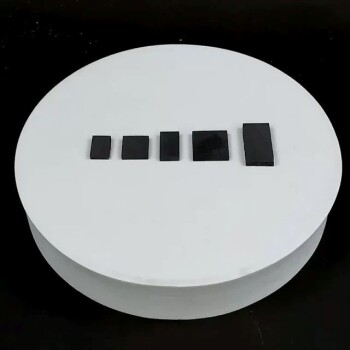
Glassy Carbon Sheet RVC for Electrochemical Experiments
Discover our Glassy Carbon Sheet - RVC. Perfect for your experiments, this high-quality material will elevate your research to the next level.
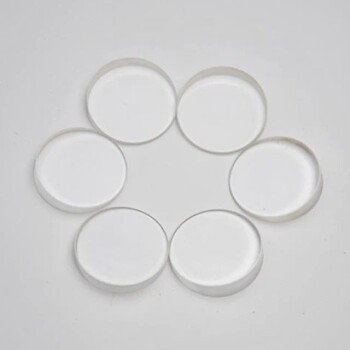
Optical Window Glass Substrate Wafer CaF2 Substrate Window Lens
A CaF2 window is an optical window made of crystalline calcium fluoride. These windows are versatile, environmentally stable and resistant to laser damage, and they exhibit a high, stable transmission from 200 nm to about 7 μm.

Zinc Selenide ZnSe Optical Window Glass Substrate Wafer and Lens
Zinc selenide is formed by synthesizing zinc vapor with H2Se gas, resulting in sheet-like deposits on graphite susceptors.
Related Articles

Glassware vs. Plasticware - Which is the Better Choice for Your Needs?
Both glassware and plasticware have their own advantages and disadvantages, and the choice between the two will depend on the specific needs of your laboratory.

Unveiling the Exceptional Properties and Applications of Optical Quartz Plates
Discover the remarkable characteristics and diverse applications of optical quartz plates, including their superior ultraviolet transmission, thermal stability, and use in lenses, lighting devices, and semiconductor manufacturing.

How To Clean Laboratory Glassware - Part 1
Cleaning laboratory glassware isn't as simple as washing the dishes. Here's how to wash your glassware so that you won't ruin your chemical solution or laboratory experiment.

How to Save Money When Buying a Rotary Evaporator (Rotavapor)
A rotary evaporator, also known as a rotavapor, is a laboratory equipment commonly used to remove solvents from a sample. It works by rotating the sample flask to create a thin film of the solvent, which is then evaporated.

Optical Quartz Plate: A Comprehensive Guide to Applications, Specifications, and Usage
Discover the versatility of optical quartz plates, exploring their uses in various industries, key specifications, and factors that differentiate them from glass. Gain insights into their applications in ultraviolet transmission, precision optics, and more.

Comprehensive Guide to Atmosphere Furnaces: Types, Applications, and Benefits
Explore the world of atmosphere furnaces with our detailed guide. Learn about their types, applications in metallurgy and beyond, and the benefits they offer for precise material heat treatment.

Common Instrumentation and Operations in Organic Synthesis
Overview of essential glass apparatus, distillation setups, recrystallization, and extraction methods in organic synthesis.

Understanding Fused Silica: Properties, Applications, and Advantages
An in-depth look at fused silica, its unique properties, and its diverse applications in various industries.

Common Optical Materials and Their Properties
An overview of various optical materials, their properties, and applications across different spectral ranges.

The Rise of Glass Substrates in Advanced Semiconductor Packaging
Explores the shift towards glass substrates in advanced semiconductor packaging, their advantages, and challenges.

Key Properties and Differences Between Fused Silica and Natural Quartz
A detailed comparison of the properties, appearance, physical, chemical, and application differences between fused silica and natural quartz.

Comprehensive Overview of Fused Silica: Properties, Production, Applications, and Market Prospects
An in-depth exploration of fused silica, its properties, production process, diverse applications, and promising market outlook.